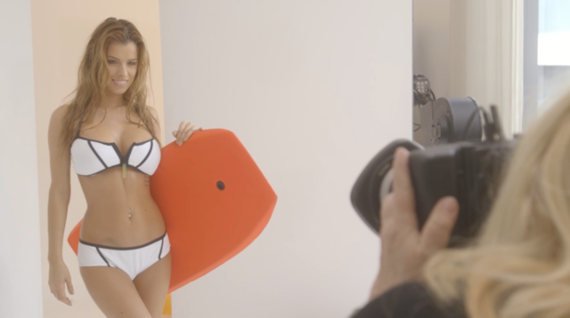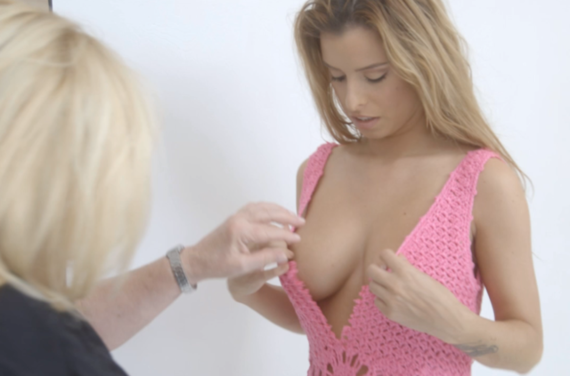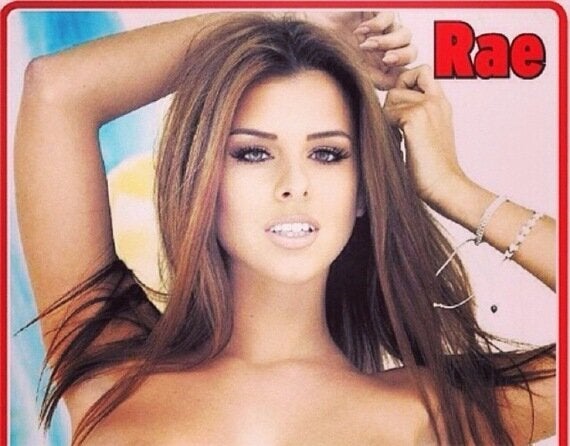It's been almost a year to the day since the Sun stopped printing Page 3.
For months, 'No More Page 3', a campaign group led by Lucy Holmes, had worked tirelessly to remove topless models from the Sun. The campaign compared the feature to "soft porn", stressing that it was 'inappropriate' for a family newspaper, and that it objectified women.
Bare breasts obviously aren't news, but what if these women like being objectified? What if these women like the crude comments from men or enjoy flaunting their bodies for attention?
Last summer, I met a glamour model who completely changed my opinion on the glamour industry. The Sun's removal of Page 3 had come into effect a few months prior, and I was curious as to whether this had stopped girls like her from getting work.
Despite modelling myself, I'd held a certain contempt and elitist attitude towards glamour models. I would stalk them on social media and view them with disdain - the sexual poses, the provocative posts and the lecherous comments they'd receive; forgetting that I, too, would receive such comments and had sometimes posed in similar positions for high fashion, all for 'likes', attention and money.
I'm ashamed to say I judged these women, forgetting that just as I'd had the privilege of choosing modelling as my job, they too had this entitlement.

I towered above Rae, a petite and bolshy 25 year-old, who frequented Page 3 and lads mags often with a loyal fan base. She would receive sacks of fan mail from men around the world, be showered with messages of affection online, and her topless calendar would sell out annually. Her genetics, like Victoria's Secret models, had made her successful.
Like the other glamour models I met, she loved the male attention. She enjoyed manipulating men with her provocative social media posts, flaunting her femininity and using the sexual power that being female grants you. Her photos and captions were suggestive, and men loved it.
It was refreshing to see Rae embracing her sexuality. She was proud to be a woman and there is something incredibly sexy about a woman aware of her beauty.

I watched her pose on a Page 3 shoot, bouncing topless on a blow-up ball. The atmosphere was so asexual, I might as well have been watching a pantomime. Although it would've been slightly hard not to notice Rae's huge breasts, the men on set weren't leering at her. She was the person in control - not only in the room, but of the image she was portraying.
It was a far cry from the fashion shoots I was used to, where the lines between sex and fashion have become increasingly blurred. Unlike fashion models, who are often asked to go nude or topless without being asked beforehand, glamour models know what they are posing for. Their topless photo doesn't just 'miraculously' turn up on Page 3, nor does the (very) minimal pay cheque mysteriously land into their bank.
What they hope for, like millions of other girls, is that their lucky break will come; that they'll become the next Jordan or Caprice and make their millions.

Lads mags and Page 3 disgusted me, as did the sexist, misogynistic 'culture' which followed them, and I believed girls like Rae were merely encouraging men to treat women a certain way. They bred the type of boys - and later, men - who would grope you on a night out; the type to make a mockery out of women, of feminism and of how far we had come.
But it wasn't until I compared a few Page 3 cuttings to online porn that it dawned on me just how mild Page 3 actually is. In fact, I'd seen cruder poses in fashion advertisements or editorials.
Here's the reality: sex sells. Men like looking at pretty women, and women like to feel lusted after. Men will always source a way of finding naked pictures of women, and there are many women who will pander to that.
And yes, a woman's worth is based on more than her looks. But not all women are designed to work in an office or be charity workers.
Therefore, it seems a shame that we've taken something relatively 'meek' and placed it in the same league as online porn. The idea that a photograph of a cheeky, topless woman could ever be compared to a pornographic video is surely incomprehensible to even the most prudish of minds.

Rae and I didn't know it at the time, but soon came the announcement that FHM and Zoo were to suspend publication. Playboy also announced it would stop printing nude models from March this year, instead choosing to pursue a more "fashion-led" publication. The world of glamour modelling suddenly became smaller, and the opportunities fewer.
For a working-class girl like Rae, whose family read red-top papers, glamour modelling was a way of making something for herself, just as it had been for the likes of Kelly Brook or Katie Price. Modelling for a newspaper like the Sun or Daily Star is often viewed as an achievement.
The truth is that, whilst print magazines are dwindling year on year, glamour models simply don't compete with the dirtier (and free!) videos or images available online. Men want more, and we've pandered to it. Mainstream media is getting filthier every day, meaning women like Rae are having to turn to "seedier" work in order to keep up with those demands, such as porn, live cams or escorting, all because of a feminist backlash.
The only difference between mine and Rae's jobs are our body shapes. We're both selling the same thing: sex. But you never see a thin, flat-chested model on Page 3, just like you don't see a glamour girl with Double D's in Vogue. Our sexually-charged facial expressions or poses are often similar, yet because fashion is aimed at a female or gay audience, it's considered acceptable.
As a society, we say that thin bodies with small breasts are couture-worthy, but rarely worthy enough for male attention. We put a petite girl with huge boobs in a family newspaper and it's instantly seen as sexual, but never 'fashionable'. A fashion model can stand there seductively and topless with no questions asked; a glamour girl will stand there topless and smiling, and suddenly she's letting women down.
To the 'No More Page 3' campaigners, large breasts screamed "sex". We've subconsciously placed women into categories and judged them based on their builds. Curves mean you're open to male objectification, never femininity.
There is nothing anti-feminist about wanting to look good or be desired, for yourself or for male attention. But there is something wrong when a self-proclaimed feminist tells other women how to behave.
And this is why I have a problem with the 'No More Page 3' campaign. You cannot state that you support and fight for women, all whilst telling some of those women what lifestyle choices are acceptable or not. There will never be anything feminist about that.
